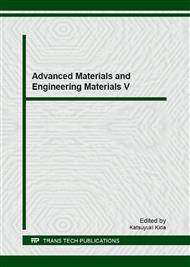p.49
p.56
p.61
p.65
p.70
p.76
p.81
p.87
p.94
Thermoelectric Properties of Silicon Germanium Alloy Nanocomposite Fabricated by Mechanical Alloying and Spark Plasma Sintering
Abstract:
High dense p-type Si95Ge5 doped with nanoSi70Ge30B5particles thermoelectric materials were firstly fabricated by mechanical alloying (MA) and spark plasma sintering (SPS) method. The effects of different nanoSi70Ge30B5 doping content on the thermoelectric and phase properties were studied. A dimensionless thermoelectric figure-of-merit (ZT) of 0.47 at 710K in p-type nanocomposite bulk silicon germanium (SiGe) alloys is achieved. The enhancement of ZT is due to a large reduction of thermal conductivity caused by the increased grain boundaries of the numerous nanograins that effectively scatter long wavelength phonons.
Info:
Periodical:
Pages:
70-75
Citation:
Online since:
August 2016
Authors:
Price:
Сopyright:
© 2016 Trans Tech Publications Ltd. All Rights Reserved
Share:
Citation:


